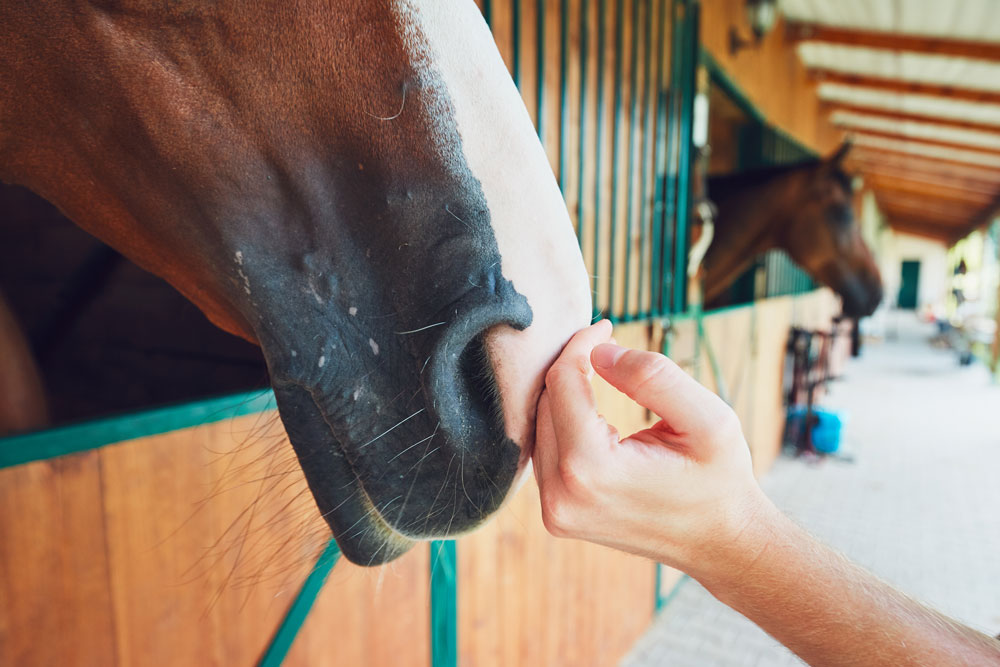
If you are in a high-risk area where there’s a greater incidence of EHV-1 cases, the following tips may help ensure the horses in your care are protected from infection. These precautionary strategies come directly from Nathan Slovis, DVM, DACVIM, CHT, at Hagyard Equine Medical Institute. As an internal medicine specialist and the Infectious Disease & Biosecurity Director, he has implemented the current Infectious Disease and Equine Emergency Response Programs at Hagyard.
1. Start monitoring your horse’s temperature twice daily. Even if your horse has not been exposed, start recording their temperature now to understand what their normal baseline temperature is. A horse’s temperature will usually spike prior to shedding significant amounts of the virus, and typically anything greater than 101.5°F should be considered a fever. If a fever is noted, you should isolate the horse to the best of your ability until a veterinarian can assess. It is recommended that any horse with a fever have both a whole blood sample and nasal swab submitted for PCR assessment for EHV-1 and EHV-4.
2. Limit exposure to any stressful situations that are not necessary. Examples include elective surgeries and other medical procedures. Minimizing stress will help protect the immune system so it can better fight off infection.
3. If your horse requires the use of corticosteroids, either systemically or intraarticularly, consult your veterinarian to see if it is feasible to stop administration. The continued use of corticosteroids can suppress the immune system and could hinder their ability to effectively fight off an infection.
4. Increase biosecurity measures since humans can inadvertently spread the infection on their hands, grooming equipment, etc. EHV-1 can survive on inanimate objects like halters, lead ropes, and tack, but is easy to kill on surfaces with disinfection. Therefore, these simple biosecurity measures can help stop the spread:
- Wash or sanitize your hands between interacting with each horse.
- Take care when filling water buckets and feed tubs—neither the hose nor the feed scoop should have contact with the bucket or tub.
- Minimize the use of shared equipment, disinfecting tack (bits, bridles, etc.) between horses. Items like water buckets and feed tubs should not be shared.
There are a multitude of safe and effective disinfectants available. A few I recommend are a 1:4 ratio of bleach to water, or accelerated hydrogen peroxide-based disinfectants (like Rescue) since they are safe for both human and animal use.
5. Keep your horse up to date with their EHV vaccine schedule. If you horse has not been vaccinated against EHV three months prior to travelling into an area that has a high incidence of EHV, then I would recommend vaccinating your horse. If you are in a high-risk area, consult your veterinarian about the use of vaccines that have a high antigenic load for herpes virus so you can get a robust immune response. Remember, there is no vaccine on the market that can prevent the neurological form of EHV-1. The goal of vaccinating is to reduce the severity of clinical signs and reduce shedding of the EHV-1 virus if a horse does get sick.
Some inactivated vaccines with the highest number of antigens for virus neutralization include Calvenza®, Pneumabort-K® and Prodigy®. Other vaccines like Rhinomune® are a modified live vaccine, and also have a high virus neutralization response.
6. If your horse is exposed or gets sick, contact your veterinarian to see what course of action they recommend. As mentioned, diagnosis requires the detection of the virus from either whole blood or nasal swab samples via PCR testing. If you are in a barn with a horse that has EHV-1, the use of the antiviral drug valacyclovir may decrease virus shedding and may help your horse from acquiring the infection. Veterinarians have also discussed the use of lysine to theoretically reduce viral replication. Horses can be administered safely 12 grams orally once daily in their feed. This has not been proven to prevent neurological forms of EHV-1.
In the neurologic form of EHV-1, the virus interacts with the blood vessels that supply the spinal cord. This inflammation in the blood vessels can cause a stroke-like event (blood clot), resulting in decreased blood flow to that portion of the spinal cord. To potentially prevent this from happening, veterinarians may prescribe anticoagulants like aspirin and/or heparin to prevent this from happening if your horse becomes clinical.
To learn more about equine herpesvirus, Slovis recommends referring to the American Association of Equine Practitioners (AAEP) website for accurate information and resources.


